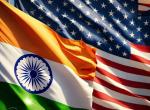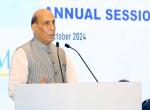India’s tender for 126 Medium Range Multi-role Combat Aircraft (MMRCA) has been the object of intensive and prolonged international interest. Such a massive order for advanced aircraft by a single country for procurement from the international market is rare. All the major defence equipment exporters in the world have been eyeing this $10 billion contract avidly, with US, Russia, France, Sweden and the European consortium of Germany, UK, Italy and Spain in the fray. The total value of this contract will, of course, be much more than the $10 billion price tag being curently mentioned if the supply of spare parts, upgrades etc over the 30 to 40 year service life of the aircraft is taken into account. There are other fall-outs also, as such a major contract creates mutual stakes and networks of cooperation between defence establishments, with a catalytic effect not only in enhancing defence cooperation in general, but in improving political relations as well.
A lot of suspense has accompanied this tender, with a great deal of uncertainty about which aircraft would eventually be shortlisted for final selction. Observers were unclear whether the evaluation process would be purely technical, or would be influenced by political considerations. In any case, the general belief is that decisions on such high-value defence contracts that have an important political fall-out can never be divorced from politics and therefore can never be purely technical.
The lack of confidence in our defence procurement process, with its inordinate delays and lack of transparency, added to speculation about the time-frame of decision making. The marked bureaucratic apathy in the Ministry of Defence, with officials inclined to avoid taking responsibility for decisions and delaying them as much as possible so as to protect themselves from potential controversies later, was seen as good reason to expect procrastination. The noxious games played by competing companies against each other, roping in members of parliament and planting press articles to cast doubt on the probity of the evaluation process and the final award, which has featured as an unpalatable side-show of defence deals in India, was expected to play its part too in deferrring decisions.
It was widely believed that the evaluation process would be highly complex in any case, with the performance parameters listed for the aircraft being too numerous, and none of the competing aircraft expected to meet all of them in trials. Beyond this, it was bandied about by cynics that even if the Air Force were to do a purely objective performance-based exercise in evaluating the aircraft, its final recommendation would watch for signals from the Ministry of Defence.
In the event, the evaluation process for the MMRCA deal has proceeded remarkably well. A very difficult exercise has been completed in good time. Confidentiality has been maintained, apart from the bizarre instance of an off-sets related file being found in a most unlikely place. Despite efforts by interested parties to probe into the progress of the evaluation process, no substantial leakage of information seems to have occurred, indicating, to the credit of those involved, that the integrity of the process was maintained. The most striking aspect of the technical evaluation is, however, the rather unexpected result. Only the Eurofighter and the Rafale have been retained in the short list for final selection; the two US aircraft have been excluded from further consideration.
The most active in striving to win the MMRCA contract have been the US companies. Their preparatory work in the field has been the most vigorous at the political, official and business levels, including tying up with Indian companies in the private sector for fulfilling the exacting off-set obligations of the contract- upto 50% of its value. The Americans understood no doubt that this contract provided an opportunity to capture a large share of the Indian defence market, changing dramatically the paradigm of India-US defence ties, hitherto marked by reticence on the Indian side to put itself in a position of long term dependence on the US for a crucial part of its defence preparedness. The Americans must have also judged that the political conditions had become sufficiently favourable to them to eye this massive contract seriously, with the rise of trust levels in the US in the Indian security establishment after the Indo-US nuclear deal, and with a perceived pro-US government in power in Delhi.
The Americans seemed to have proceeded on the assumption that with India placing orders for advanced US defence equipment such as 6 C-130J aircraft and 8 P-8I long range maritime patrol aircraft, doubts about the reliability of the US as a defence equipment supplier had abated. They may have also concluded that their policy of supplying arms to Pakistan, including F-16 aircraft, no longer disqualified them from selling advanced aircraft to India, including F-16s. The problem of restrictive conditions that the US imposes on arms sales to third countries, such as end-use monitoring, that India finds intrusive and unpalatable, would have seemed to them to have been basically addressed with our acceptance of such conditions in other deals concluded with them.
In this background, the exclusion of the two US aircraft from the competition after the completion of the technical evaluation process by the indian Air Force has run counter to all expectations. Given the political lobbying by the US in favour of the US companies, the thoroughgoing field work done by US companies to position themselves favourably to win the contract and the incessant talk about the political transformation of US-India ties and the growing strategic partnership between the two countries, it seemed highly unlikely that the Indian government would have the political option of omitting the US aircraft from even the shortlist of final contenders.
The US rhetoric that it considered its relationship with India as an indispensable one for the 21st century, the breadth of the engagement between the two countries, the in-principle support given by the US for India’s permanent membership of the UN Security Council, the encouragement to India to play a more active role in the eastern part of Asia with concerns about China’s rise no doubt in mind, all worked in favour of strengthening perceptions that the ground for this major contract going to the Americans was being laid. The declared willingness of the US to ease export controls applicable to India and the removal of most of the remaining Indian organizations from the US Entity List, especially the DRDO related ones, could also have been interpreted as a move to set at rest India’s concerns about technology transfers within the ambit of a growing defence relationship with the US.
Any veritable strategic relationship must have defence ties as a component. If India takes its strategic relationship with the US seriously, it has to factor into the equation an arms procurement relationship. A strategic partnership cannot be developed without trust, and if India were to continue to question how much trust it can repose in the US as a defence partner, an important ingredient would be lacking in fostering a really close relationship in the future.
But then, the record of the US in imposing sanctions not only on India, but also a host of other countries, cannot be ignored. Even if today India’s relationship with the US Administration is better than ever before, there is no guarantee that differences on some sensitive issue in the future will not push the US political process towards sanctions, or a threat to impose them, in order to constrain India’s freedom of choice. A conflict with Pakistan could be an example, especially as the US is selling arms to both sides, and US arms will be used by both in case of active hostilities. This may well prompt the US Congress to seek to impose an arms embargo on both countries, especially in the context of fears of a nuclear exchange in the sub-continent if any military confrontation is not quickly contained.
Iran is another example of potential differences emerging between India and the US. The US is ultra-sensitive about any form of military cooperation between Iran and India. Iran is under stringent US sanctions over and above the UN approved ones, and this has not only frozen India-Iran discussions on energy projects, India is now finding it difficult to even pay for the large quantities of crude oil it buys from Iran. This is so because of the control the US exercises over all dollar transactions with Iran, an oversight that the EU now applies to euro transactions too, and the reluctance of Indian and other banks to run the risk of disrupting their normal operations by disregarding the US and EU sanctions because of their extra-territorial nature. This disruption is happening even when procurement of crude from Iran is not otherwise subject to sanctions. Such restrictions damage India’s energy security on which an understanding with the US within the ambit of a “strategic” relationship is absent.
In the context of the MMRCA deal, US arms supplies to Pakistan did not acquire a political profile that the issue merited in principle. Why the incongruity of the US supplying frontline fighters to Pakistan, given the latter’s unremitting hostility towards india, its diversion of American funds intended for building up its counter-terrrorism capabilities to acquisition of India-specific arms, its unwillingness to act firmly against jihadi groups targetting India and procrastination in bringing those responsible for Mumbai to justice, and, at the same time, seeking to sell similar aircraft to India, has not attracted more critical political-level attention in India is surprising. There would have been, on the face of it, something wrong and undesirable in the same American company supplying aircraft to both India and Pakistan, in better equipping militarily two long time adversaries in their mutual confrontation.
The US explains its policy of arming Pakistan as intended to give it a greater sense of confidence in its own security and deflect it from expanding its nuclear force by enhancing its defensive conventional capability. The US rejects occasional official Indian criticism by arguing that India is much more powerful militarily than Pakistan and that its arms transfers are carefully calibrated not to upset the conventional military balance in the sub-continent. It has let it be known that it does not intend to change this policy, and that on this subject the two sides can agree to disagree. We do know that this arms aid is also intended to lubricate the willingness of the Pakistani army to cooperate with the US in combatting extremists operating from the country’s frontier areas against US/NATO forces in Afghanistan. All in all, whatever the US calculations and compulsions, US arms sales encourage Pakistan to pursue its policy of confrontation against India. From the Indian point of view, if the US can impose an arms embargo against China despite the intensity of their economic and financial ties and the need to manage their conflicting strategic interests in East Asia which carries its own compulsions of keeping China in good humour, why cannot the US revise its policy of arming a country that is unstable, almost failing as a state in US eyes, irresponsible on nuclear matters, and most responsible for the dangerous spread of extremism and terrorism in the region and well beyond?
The Indian political establishment has been reluctant to make an issue of US arms aid to Pakistan for various reasons. Raising it aggressively at a time when India-US relations have been improving remarkably would have clouded the atmosphere by escalating public concerns on a sensitive issue. Governmental efforts to enlarge the areas of engagement and reduce the scope of differences with the US, all with a view to leveraging the US connection as much as possible for India’s sustained economic growth, would have been impeded. The Indian assessment that its protests will go unheeded by the US Administration, and therefore too much political capital should not be expended on an issue on which India would not get required satisfaction, has been a factor. Then, there are those who have argued that rather than following a negative policy of preventing the US from selling to Pakistan, India should follow a positive approach of stepping up its own purchases from the US with a view to giving a stake to the US defence industry in India, and that this may be a more powerful dissuasive factor in the long run for the US to supply advanced weaponry to Pakistan. US willingness to sell more technologically advanced weaponry to India than it does to Pakistan has also been offered as an argument not to resort to a negative, Pakistan-fixated approach, and revive the hyphenation with Pakistan that we have along resisted. Finally, raising the pitch on this issue did not fit in with the policy of resuming the dialogue with Pakistan, apart from the consideration that Pakistan would project India’s lobbying against US arms supplies as evidence of its hegemonistic designs of keeping Pakistan weak and threatening its security.
The immediate US reaction was one of shock that the US aircraft had been given such short shrift by India. It expressed officially its sense of disappointment at the result, underlining the political investment the US had made in promoting the success of its companies. It is not entirely normal for a government to publicly express such distress when its private sector companies are ousted in a commercial tender, as by doing so it only draws more attention to its own active interest in the tender, but also to the set back it received. Those who talk of US “pressure” on India can point to such governmental level reaction as proof, even if it could be argued that the decision taken demonstrated that such “pressure” was resisted, but it is not a healthy controversy to get involved in for both sides. There cannot be disappointment unless there is expectation. Why the US government expected its aircraft to be considered technically superior in performance to the other competing aircraft is not clear.
The Eurofighter and the Rafale are much newer aircraft than the F-16 and the F-18 in design. The latter represent fully mature technologies, with little room for growth especially over the next 30 years or more when the MMRCA will be in service. The European aircraft, as compared to the older American ones, therefore give the assurance of remaining at the cutting edge of technolgy for the next few decades, and more in a position to respond to the evolution in India’s threat environment over that period. Those who have analysed the comparative capabilities of the aircraft dispassionately recognize the superiority of the European platforms in aerodynamics and close combat capability, though the Americans have for the present a superior AESA radar that the Europeans too are in the process of developing, and which is expected to be ready when the chosen aircraft goes into service in India eventually.
India is following a two step process in the MMRCA acquistion, with a purely performance based technical evaluation process to be followed by commercial negotiations and concomitant questions of technology transfer and off-sets. The intention is to follow a transparent process and insulate it as far as possible from political predilections and charges of financial impropriety. If the American critics of the Indian decision argue that India has missed the opportunity to reinforce its strategic partnership with the US, implying, in other words, India has not considered political factors in making the decision, they are in fact arguing against transparency and objectivity in selection, as political considerations can be invoked in favour of the Europeans or the Russians also, and cannot play only in favour of the Americans.
The European aircraft are certainly more expensive than the American aircraft, but the view of some US commentators that the cost of the aircraft should have weighed in the initial shortlisting by India also cuts both ways. If the American planes are cheaper, the Russian and the Swedish planes are cheaper still. The criticism that India has bought a plane and not a relationship is a bit presumptuous, as it implies that India has short changed itself. There is here a suggestion that the acquisitions already made from the US and those in the offing will not build a relationship with the US. The US should actually build a partnership with India, and avoid giving the impression that it looks upon it as a client to whom favours are dispensed by selling defence equipment. Incidentally, after the announcement that the Cabinet Committe on Security had approved the C-17 deal, a US spokesman said that with this acquisition India will have the largest number of these planes in service outside the US. He also said that this purchase will not have any bearing on US policy on arms sales to Pakistan.
After the initial voicing of disappointment with the Indian decision, the American tone changed, with officials stating they had no reproach to make about the Indian selection process, that the India-US defence relationship did not hinge on the result of a single project, that the US will continue to look for opportunities to strengthen defence ties with India and that its companies will pursue their efforts to increase their share of the Indian defence market. This modulated approach was wise, as the US can look forward to a meaningful share of the US $ 35 billion worth of defence acquisitions India plans to make in the next 5 years. Already the government has cleared the purchase of 10 C-17 heavy lift aircraft worth $ 4.1 billion, a timely decision to offset the negative impact of the MMRCA decision on the US mind. US suppliers are also expected to bag the contracts for the supply of attack helicopters, light howitzers and anti-tank guided missiles. All this shows that despite the jagged edges in the India-US defence relationship, the trend lines in these ties are positive.
It is clear India’s MMRCA will be a European aircraft, which is a judicious decision in view of Europe’s established role in meeting our defence needs and its importance as a strategic partner. But this is not at the cost of an expanding defence relationship with the US in the years ahead.
---------------------------------------
Published in Indian Defense Review








Post new comment